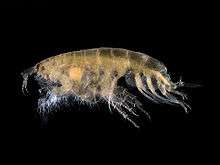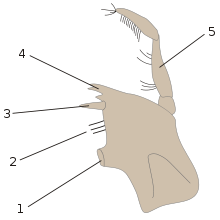Peracarida
| Peracarida | |
|---|---|
 | |
| The amphipod Bathyporeia elegans with an egg in its marsupium | |
| Scientific classification | |
| Kingdom: | Animalia |
| Phylum: | Arthropoda |
| Subphylum: | Crustacea |
| Class: | Malacostraca |
| Subclass: | Eumalacostraca |
| Superorder: | Peracarida Calman, 1904 [1] |
The superorder Peracarida is a large group of malacostracan crustaceans, having members in marine, freshwater, and terrestrial habitats. They are chiefly defined by the presence of a brood pouch, or marsupium, formed from thin flattened plates (oostegites) borne on the basalmost segments of the legs.[2] Peracarida is one of the largest crustacean taxa and includes about 12,000 species. Most members are less than 2 cm (0.8 in) in length[3] but the largest is probably the giant isopod (Bathynomus giganteus) which can reach 76 cm (30 in).[4]
Characteristics

The most obvious characteristic of the group is the marsupium in females. This brood pouch is enclosed by the large, flexible oostergites, bristly flaps which extend from the basal segments of the thoracic appendages, which form the floor of a chamber roofed by the animal's sternum. This chamber is where the eggs are brooded, development being direct in most cases.[3] Other characteristics include the possession of a single pair of maxillipeds (rarely 2–3), of mandibles with an articulated accessory process between the molar and incisor teeth in the adults (called the lacinia mobilis), and of a carapace which is often reduced in size and is not fused with the posterior thoracic somites.[5] In some orders, the young hatch at a post-larval, prejuvenile stage called a manca which lacks the last pair of legs.[5] In the underground order Thermosbaenacea, there are no oostergites and the carapace of the female is expanded to form a dorsal marsupium.[3]
Orders
There is some disagreement as to which orders should be included within Peracarida. Martin & Davies include the following eleven orders:[6]
- Amphipoda Latreille, 1816
- Cumacea Krøyer, 1846
- Isopoda Latreille, 1817
- Lophogastrida G. O. Sars, 1870
- Mictacea Bowman, Garner, Hessler, Iliffe & Sanders, 1985
- Mysida A. H. Haworth, 1825
- †Pygocephalomorpha Beurlen, 1930 (only known from fossil remains)
- Spelaeogriphacea Gordon, 1957
- Stygiomysida Tchindonova, 1981
- Tanaidacea Dana, 1849
- Thermosbaenacea Monod, 1927
but Ruppert, Fox and Barnes exclude Thermosbaenacea and place it in a separate order, Pancarida. They also place Lophogastrida, Mysida and Pygocephalomorpha in a single order, Mysidacea.[3] This arrangement is disputed by Meland and Willassen who found that molecular data shows that the three orders are not closely related.[7]
References
- ↑ W. T. Calman (1904). "On the Classification of the Crustacea Malacostraca". Annals and Magazine of Natural History. 13 (74): 144–158. doi:10.1080/00222930408562451.
- ↑ G. C. B. Poore (2002). "Superorder: Peracarida Calman, 1905". Crustacea: Malacostraca. Syncarida, Peracarida: Isopoda, Tanaidacea, Mictacea, Thermosbaenacea, Spelaeogriphacea. Zoological Catalogue of Australia. 19.2A. CSIRO Publishing. pp. 24–25. ISBN 978-0-643-06901-5.
- 1 2 3 4 Ruppert, Edward E.; Fox, Richard, S.; Barnes, Robert D. (2004). Invertebrate Zoology, 7th edition. Cengage Learning. p. 652. ISBN 978-81-315-0104-7.
- ↑ Daily Mail Reporter (April 3, 2010). "Monster of the deep: Shocked oil workers catch two-and-a-half-foot 'woodlouse'". The Daily Mail. London. Retrieved January 24, 2014.
- 1 2 "Peracarida". Guide to the marine zooplankton of south eastern Australia. Tasmanian Aquaculture & Fisheries Institute. June 2008. Retrieved August 30, 2011.
- ↑ Martin, J. W. & G. E. Davis (2001). An Updated Classification of the Recent Crustacea (PDF). Natural History Museum of Los Angeles County. pp. 132 pp.
- ↑ Meland, K.; Willassen, E. (2007). "The disunity of "Mysidacea" (Crustacea)" (PDF). Molecular Phylogenetics and Evolution. 44 (3): 1083–1104. doi:10.1016/j.ympev.2007.02.009. PMID 17398121.
External links
- Gary Anderson (May 7, 2011). "Peracarida Taxa and Literature (Cumacea, Lophogastrida, Mysida, Stygiomysida and Tanaidacea)". University of Southern Mississippi.
 Data related to Peracarida at Wikispecies
Data related to Peracarida at Wikispecies